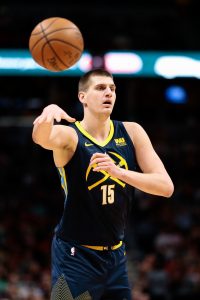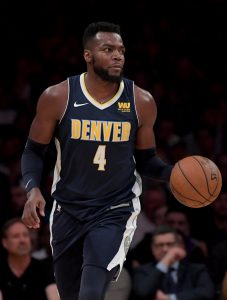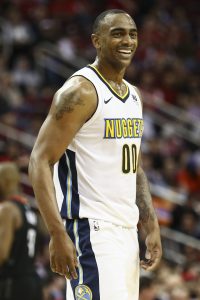After missing the playoffs for four straight seasons, the Nuggets were a popular choice to climb back into the top eight in the Western Conference this year. Denver improved to 46-36, but a loss to the Timberwolves on the final day of the regular season prevented the team from earning a postseason berth in an extremely competitive conference.
There’s reason to believe that the Nuggets are still on the rise — many of their key contributors are still less than 25 years old, and the team will count on top 2017 free agent addition Paul Millsap to be healthier next year. However, the franchise no longer has substantial cap room available. In fact, certain moves could push Denver’s team salary beyond the luxury-tax line, which may not appeal to club ownership.
Here are five key questions facing the franchise this summer:
 1. What will the Nuggets do with Nikola Jokic?
1. What will the Nuggets do with Nikola Jokic?
The most fascinating question the Nuggets will have to answer involves the future of Jokic, who looks like a franchise center. Denver’s leader last season in PPG (18.5), RPG (10.7), APG (6.1), and 3PT% (.396), Jokic is an offensive force, and one who is playing on a very team-friendly salary. The Nuggets hold a team option for 2018/19 worth just $1.6MM.
So what’s the problem? Well, if Denver exercises that team option, it would put the 23-year-old on track for unrestricted free agency in 2019. At that point, the Nuggets would be able to offer him more years and money than any other team, but they wouldn’t have the right of first refusal, and would risk losing him for nothing. Plus, delaying his payday by another year wouldn’t endear the Nuggets to Jokic’s representatives, who have strongly suggested that declining the option would be in the club’s best interests.
As such, the most likely outcome is the Nuggets turning down that option in order to make Jokic a restricted free agent, at which point the two sides could work out a new long-term agreement and Denver wouldn’t have to worry about potentially losing their rising star on the open market.
2. How can the Nuggets trim salary?
The problem with giving Jokic a lucrative new deal this summer is that it would create some financial issues for the Nuggets. If we assume Jokic gets a max contract or something close to it, that could add another $25MM to Denver’s team salary for 2018/19. The team already has about $85.6MM in guaranteed money on its books, with player options for Wilson Chandler ($12.8MM) and Darrell Arthur ($7.5MM) likely to follow. The cost of the Nuggets’ roster would increase to approximately $131MM if we count all those deals, and that’s without accounting for free-agent-to-be Will Barton.
In other words, the Nuggets will probably need to find a way to cut costs.
Fortunately, Denver should have a handful of players in contract years. In addition to Chandler and Arthur, Kenneth Faried ($13.8MM) will be entering the final season of his deal. The team hasn’t been able to find a taker for Faried in the past, but with just one year left, more potential trade partners may surface.
Still, Faried and Arthur won’t be easy to move, so Chandler is probably the most logical trade chip for the Nuggets. The 31-year-old is a solid three-point shooter (.358 3PT% in ’17/18) and defender capable of playing either forward position, and the Nuggets were better with him on the court than off it last season, so he should appeal to contending teams.
Of course, those are all reasons why Denver might prefer to keep Chandler on the roster, particularly since the club doesn’t have a ton of reliable small forward depth. If they keep Chandler, the Nuggets would probably have to pair Faried, Arthur, or Mason Plumlee with a more valuable asset in order to find a taker. Waiving and stretching a player or two is also an option if absolutely necessary. Arthur’s 2018/19 cap charge could be reduced by about $5MM if he’s stretched, for instance.
Read more
3. Could the Nuggets’ power forward logjam lead to trade opportunities?
With Jokic locked in at the five and Plumlee backing him up, the Nuggets don’t need Millsap to be a small-ball center too often, which means he’ll see most of his action at the four. If he stays healthy and averages 30+ minutes per game, that doesn’t leave much playing time for Denver’s other power forwards, and the team has a lot of them.
Besides Faried and Arthur, Trey Lyles, Juan Hernangomez, and Chandler all saw action at the four last season. Lyles enjoyed a modest breakout season as a regular rotation player, exhibiting an ability to knock down shots (.491/.381/.697). Hernangomez took a step backward in his sophomore year, but showed promise as a rookie and is still just 22 years old, so he could push for a larger role.
Denver probably needs a trade or two to better balance its roster, and while the team would certainly prefer to move those highly-paid players like Faried and Arthur, including Lyles or especially Hernangomez in a trade package could make sense in the right move.
4. Will the Nuggets re-sign Barton?
Barton will enter unrestricted free agency following the most productive year of his NBA career (15.7 PPG, 5.0 RPG, 4.1 APG), and his play-making and ball-handling abilities make him an ideal sixth man for the Nuggets. However, he’ll likely draw interest from teams around the league who envision him in a similar role on their own rosters, so Denver will have to give him a raise and a multiyear deal to keep him.
We’ve already discussed the Nuggets’ potential salary issues at length, but the team would be under even more pressure to move salary if Barton re-signs. Still, he might be worth it, depending on how high his price tag goes. If a team with cap room makes an aggressive play for the veteran guard, Denver may not be equipped to top that offer, but as long as his price stays in the mid-level range, the Nuggets should do all they can to keep him.
5. What will the Nuggets do with their lottery pick?
If they have to let Barton walk or trade Chandler this summer, the Nuggets will find themselves in desperate need of wing depth, and the No. 14 pick in this year’s draft might be an ideal spot to replenish that depth.
Lonnie Walker, Miles Bridges, and Zhaire Smith are among the shooting guard or small forward candidates to be on the board when Denver’s pick arrives, and any of them would be solid fits. In his most recent mock draft, ESPN’s Jonathan Givony has Bridges going to the Nuggets at No. 14, observing that the MSU product has the potential to become a “two-way forward who can guard all over the floor.”
Depending on how cost-conscious the Nuggets are, the No. 14 pick could also become a valuable tool to help clear salary. The Pelicans/Bulls midseason trade involving a first-round pick and Omer Asik for Nikola Mirotic provides a point of reference here. If Denver attached its lottery pick to Faried and/or Arthur, the team could still ask for a useful rotation player in return.
Here’s where things currently stand for the Nuggets financially:
Guaranteed Salary
- Paul Millsap ($29,730,769)
- Gary Harris ($16,517,857)
- Kenneth Faried ($13,764,045)
- Mason Plumlee ($12,917,808)
- Jamal Murray ($3,499,800)
- Trey Lyles ($3,364,249)
- Juan Hernangomez ($2,166,360)
- Tyler Lydon ($1,874,640)
- Malik Beasley ($1,773,840)
- Total: $85,609,368
Player Options
Team Options
Non-Guaranteed Salary
Restricted Free Agents
Unrestricted Free Agents / Other Cap Holds
- Devin Harris ($8,364,837): Bird rights
- Will Barton ($6,713,333): Bird rights
- No. 14 overall pick ($2,869,353)
- Richard Jefferson ($1,499,698): Non-Bird rights
- Total: $16,823,817
Projected Salary Cap: $101,000,000
Projected Cap Room: None
- Even if Chandler turns down his player option, Arthur is a virtual lock to exercise his, and Jokic will be back — either on his cheap team-option salary or on a lucrative new deal. With their nine guaranteed contracts, Arthur’s player option, Jokic’s team option, and the cap hold for their lottery pick, the Nuggets already have a total team salary of $97,544,153, essentially eliminating cap room. If Chandler opts in and the Nuggets want to sign Jokic to a new contract this summer, the team projects to be way over the cap.
Note: Rookie scale cap holds are estimates based on salary cap projections and could increase or decrease depending on where the cap lands.
Salary information from Basketball Insiders was used in the creation of this post. Photos courtesy of USA Today Sports Images.

 1. What will the Nuggets do with
1. What will the Nuggets do with 